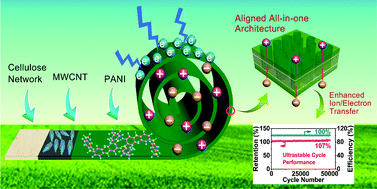Ultraflexible all-in-one supercapacitors with high capacitance and ultrastable cycle performance enabled by wood cellulose network†
Abstract
Herein, we demonstrate a structure-enabled strategy to construct an ultrastable, high-performance, ultraflexible all-in-one supercapacitor with a one-piece wood cellulose network/polyaniline/multiwalled carbon nanotube composite as both the electrodes and the separator. A cellulose network was used as the carrier and separator, and multiwalled carbon nanotube and polyaniline acted as conducting materials. Excellent flexibility was achieved by combining the cellulose network with a polyvinyl alcohol-based electrolyte. Natural directional channels in the cellulose network and the gradual distribution of the polyaniline and carbon nanotube within the structure enabled the construction of an integrated supercapacitor with reduced contact resistance between layers and improved electronic/ionic conductivity and stability. The supercapacitors resulted in a high specific areal capacitance of 0.71 F cm−2, as well as ultrastable cycle performance, which led to a 106.68% retention of the specific capacitance after 50 000 loops at a current density of 3 A g−1. The current study provides a nature-inspired strategy to rationally design and construct environmentally friendly high-performance and ultrastable energy storage devices.



 Please wait while we load your content...
Please wait while we load your content...